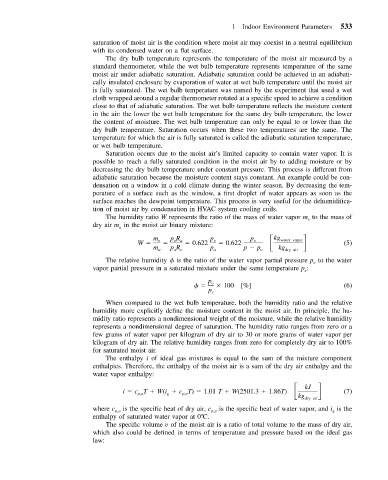Page 544 - Mechanical Engineers' Handbook (Volume 4)
P. 544
1 Indoor Environment Parameters 533
saturation of moist air is the condition where moist air may coexist in a neutral equilibrium
with its condensed water on a flat surface.
The dry bulb temperature represents the temperature of the moist air measured by a
standard thermometer, while the wet bulb temperature represents temperature of the same
moist air under adiabatic saturation. Adiabatic saturation could be achieved in an adiabati-
cally insulated enclosure by evaporation of water at wet bulb temperature until the moist air
is fully saturated. The wet bulb temperature was named by the experiment that used a wet
cloth wrapped around a regular thermometer rotated at a specific speed to achieve a condition
close to that of adiabatic saturation. The wet bulb temperature reflects the moisture content
in the air: the lower the wet bulb temperature for the same dry bulb temperature, the lower
the content of moisture. The wet bulb temperature can only be equal to or lower than the
dry bulb temperature. Saturation occurs when these two temperatures are the same. The
temperature for which the air is fully saturated is called the adiabatic saturation temperature,
or wet bulb temperature.
Saturation occurs due to the moist air’s limited capacity to contain water vapor. It is
possible to reach a fully saturated condition in the moist air by to adding moisture or by
decreasing the dry bulb temperature under constant pressure. This process is different from
adiabatic saturation because the moisture content stays constant. An example could be con-
densation on a window in a cold climate during the winter season. By decreasing the tem-
perature of a surface such as the window, a first droplet of water appears as soon as the
surface reaches the dewpoint temperature. This process is very useful for the dehumidifica-
tion of moist air by condensation in HVAC system cooling coils.
The humidity ratio W represents the ratio of the mass of water vapor m to the mass of
v
dry air m in the moist air binary mixture:
a
kg water vapor
v
W m v p R a 0.622 p v 0.622 p v (5)
m a p R v p a p p v kg dry air
a
The relative humidity is the ratio of the water vapor partial pressure p to the water
v
vapor partial pressure in a saturated mixture under the same temperature p :
s
p v 100 [%] (6)
p s
When compared to the wet bulb temperature, both the humidity ratio and the relative
humidity more explicitly define the moisture content in the moist air. In principle, the hu-
midity ratio represents a nondimensional weight of the moisture, while the relative humidity
represents a nondimensional degree of saturation. The humidity ratio ranges from zero or a
few grams of water vapor per kilogram of dry air to 30 or more grams of water vapor per
kilogram of dry air. The relative humidity ranges from zero for completely dry air to 100%
for saturated moist air.
The enthalpy i of ideal gas mixtures is equal to the sum of the mixture component
enthalpies. Therefore, the enthalpy of the moist air is a sum of the dry air enthalpy and the
water vapor enthalpy:
i cT W(i cT) 1.01 T W(2501.3 1.86T) kJ
g
p,a
p,v
kg dry air (7)
where c p,a is the specific heat of dry air, c p,v is the specific heat of water vapor, and i is the
g
enthalpy of saturated water vapor at 0 C.
The specific volume v of the moist air is a ratio of total volume to the mass of dry air,
which also could be defined in terms of temperature and pressure based on the ideal gas
law:

